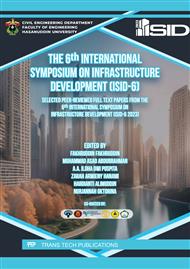p.157
p.165
p.177
p.185
p.195
p.207
p.217
p.227
p.239
A Review of Pedestrian in Rantepao North Toraja
Abstract:
A humanized pedestrian facility is built by considering the size and dimensions based on the human scale. Several studies have shown that many pedestrian facilities built in various cities in Indonesia have not been able to meet the needs of the users. This study was conducted to review the suitability of pedestrian facilities in Rantepao against existing guidelines. The research method was carried out by collecting data on pedestrian crossings and dimensions of the constructed facilities. The data was then analyzed and compared against the Pd 03-2017-B Pedestrian Facilities Planning Guidelines. The results showed that of the 20 sidewalks reviewed, only 30% could be passed by 2 pedestrians while holding hands or passing each other. While the use of zebra crossing for crossing facilities is appropriate. The transverse slope of the sidewalks all meets the requirements. The Blind cane users and crutch users can pass through the sidewalk, but wheelchair users cannot pass through safely.
Info:
Periodical:
Pages:
217-225
Citation:
Online since:
July 2025
Keywords:
Price:
Сopyright:
© 2025 Trans Tech Publications Ltd. All Rights Reserved
Share:
Citation:


